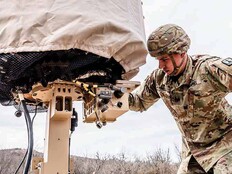I’m not a federal worker, but I imagine most of them would prefer not to spend all day doing rote, repetitive tasks that could be more efficiently handled by a machine. That would allow them to focus more on the outcome of the tasks and on higher-value work.
Increasingly, federal workers — and, perhaps more importantly, agency and government IT leaders — are realizing technology can and should be used to free users from the drudgery of tasks such as checking forms, entering data and the like.
Robotic process automation, or RPA, is a very hot technology several agencies are implementing. It’s also being encouraged by the Office of Management and Budget, which in 2018 issued a memo that directed agencies to shift resources to higher-value activities, in part by introducing technologies like RPA.
RPA allows organizations to automate certain repetitive tasks — often repetitive and tedious work that users shouldn’t spend much time doing. RPA instead lets agencies complete these tasks with higher throughput rates, fewer errors and less reliance on outside contractors.
In April, the General Services Administration created a community of practice for RPA to help federal IT leaders collaborate and determine how they could best use the technology. Speaking at the CoP’s first industry day in September, Federal CIO Suzette Kent said the Trump administration can speed the deployment of RPA and automation technology in government by fostering a “strong working relationship” between the mission and technology leadership at agencies, according to Federal News Network.
True digital transformation via RPA will come when agencies reconsider how they do tasks and coordinate with other agencies. “This not only changes the nature of work. It changes how we work together,” Kent said.
Agencies can and should learn from each other about how they are using and benefiting from RPA. By doing so, they can share best practices, figure out what works and what does not, and build a growing library of useful RPA applications across government.
VIDEO: What are the seldomly asked questions around emerging tech?
The Benefits of RPA in Government
The IRS is one of the agencies that has been enthusiastic about RPA. The agency expects to save more than 18,000 work hours through RPA pilots it rolled out in its procurement office. They help out IRS staff in the last quarter of the fiscal year, when workloads pick up.
Harrison Smith, the IRS’ deputy chief procurement officer, said that the amount of work his office has had to complete in the fourth quarter of each fiscal year has increased by 10 percent over the past five years, Federal News Network reports. At the same time, funding has decreased.
“Continually asking personnel to do more and more with less and less — it’s not something that’s feasible or tenable in the long run,” Smith said in a call with reporters. Meanwhile, the Food and Drug Administration’s Center for Drug Evaluation and Research (CDER) has been developing seven RPA projects as it looks to free up staff to focus on higher-level tasks, FedScoop reports.
CDER ensures drugs on the market are safe and effective and regulates them throughout their lifecycles, according to FedScoop. Many CDER employees have pharmaceutical science or medical degrees but often spend a lot of time on repetitive, manual tasks.
“Some of the activity is done by staff with very advanced degrees that would rather not do these kinds of tasks,” Ranjit Thomas, CDER informatics program management lead, told FedScoop. CDER estimates its RPA projects in development will save 24,000 work hours per year, including those in which bots schedule meetings and assign letters.
How to Get an RPA Project off the Ground
As with other emerging technologies, agency IT leaders looking to implement RPA should first identify a business case for the technology and how it can benefit the agency. What processes could be automated, and how can that save time and money and help the agency enhance its desired outcomes?
Another key lesson from introducing new technologies is to get buy-in from all the stakeholders. Having sponsors at a high level inside the agency’s many business units can go a long way to ensuring the success of the project.
Those implementing RPA should look to get quick wins that can demonstrate a clear return on investment to IT leaders and the CFO’s office.
Over time, as federal IT roles change, agencies may be able to attract higher-level talent with more in-demand technology skills, Edward Burrows, former robotics process automation program manager at the General Services Administration and now the vice president of intelligent solutions at government contractor Brillient, said earlier this year. For example, future IT jobs could involve managing a whole fleet of RPA bots and monitoring their performance.
“That’s a much more appealing type of job for a young person, so there are a lot of long-term benefits to the government,” he said.
Right now, it seems that RPA projects are difficult to scale. The key is to get started and see if the technology can benefit your agency.
This article is part of FedTech’s CapITal blog series. Please join the discussion on Twitter by using the #FedIT hashtag.













